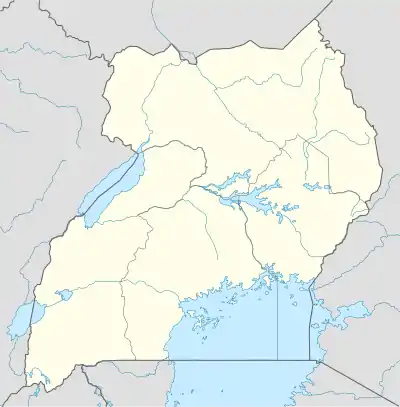Pagirinya Refugee Settlement
Pagirinya Refugee Settlement is a refugee camp in Eastern Adjumani District in Northern Uganda.
Pagirinya Refugee Settlement | |
|---|---|
 Pagirinya Refugee Settlement | |
| Coordinates: 3.353°N 31.992°E | |
| Country | Uganda |
| District | Adjumani |
Background
Pagirinya refugee settlement, as of October 2016 was one of the newest of Uganda's refugee settlements, launched in June 2016 after the Maaji Refugee Settlements reached its full capacity and could not accommodate the great number of the refugees.[1]
Population
Pagirinya refugee settlement hosts more than 32,000 refugees displaced from South Sudan. The humanitarian response across all sectors has now stabilized and is beginning to shift beyond emergency operations.[2]
Health and sanitation
A cholera outbreak hit Pagirinya refugee settlement soon after it opened which was due to the increased exposure to dirty water and unattended to water crisis at the settlement and is still a big problem to be taken care of by the Government of Uganda.[3]
Refugees reported poor latrine coverage throughout Pagirinya refugee settlement and the locals have resorted to open defecation as a final aid to the problem facing them at the camp due to the low coverage of latrines.[4]
Water supply
Factors associated with adherence to safe water chain practices among refugees in Pagirinya refugee settlement, Northern Uganda indicates that most of the refugees use poor practices for handling their water sources and eventually leading to the contracting of waterborne diseases and infections as the low level of supply of water still remains a big challenge.[5]
Education
Pagirinya refugee settlement has different schools to support education for the young children,According to UNICEF Gulu Zonal Office reports,In 2016, 13 replenishment kits were distributed to Maaji Primary School which has over 3,500 pupils to support the education of the pupils.[6]
Reports also indicate that 4,721 refugees are registered in Pagirinya Settlement in three primary schools; Pagirinya government primary school, Pariginya 1&2 feeder primary schools.
The lack of vocational training institutions has prevented both refugees and the host community from developing relevant skills to access employment opportunities or start their own businesses. This is exacerbated by the lack of capital accessible to start small scale businesses further preventing income generating activities for both communities. Moreover, refugees struggle to access items for agricultural purposes and reported challenges in accessing land to cultivate.[7]
The settlement’s organized, physical design facilitates access to important facilities, including health centres and schools.[8]
Social services
Pagirinya Refugee Settlement residents wait for transportation after collecting their monthly food stipend. They say the stipends do not last the month and residents need more land to grow food in order to add up to the available food given by the UNHCR and so farming is yet another activity that the Government of Uganda has an upright role to play in this camp.[9]
Housing and property
According to REACH reports, 77% of shelter tenure is owned by the head of the household, 12% owned by the spouse and 11% owned jointly between household member.[10]The household access to land where shelter is 99%,Accessing land in a separate plot is 3% and 1 % have no access to any land.
References
- "Uganda". The Global Compact on Refugees | Digital platform. Retrieved 2020-09-16.
- "Uganda Refugee Response Monitoring Settlement Fact Sheet: Pagirinya (June 2018) - Uganda". ReliefWeb. Retrieved 2020-09-25.
- "UNHCR working with Government of Uganda and emergency response partners to contain cholera outbreak amongst the newly arrived South Sudanese refugees in Adjumani district, Uganda". UNHCR. UNHCR. 18 August 2016. Retrieved 10 November 2016.
- "Uganda Refugee Response Monitoring Settlement Fact Sheet: Pagirinya (June 2018) - Uganda". ReliefWeb. Retrieved 2020-09-25.
- Mugumya, Thomas; Isunju, John Bosco; Ssekamatte, Tonny; Wafula, Solomon Tsebeni; Mugambe, Richard K. (2020-06-01). "Factors associated with adherence to safe water chain practices among refugees in Pagirinya refugee settlement, Northern Uganda". Journal of Water and Health. 18 (3): 398–408. doi:10.2166/wh.2020.230. ISSN 1477-8920.
- "UNICEF, UNHCR providing education to over 26,000 South Sudanese refugee primary children". www.unicef.org. Retrieved 2020-09-16.
- "Uganda Refugee Response Monitoring Settlement Fact Sheet: Pagirinya (June 2018) - Uganda". ReliefWeb. Retrieved 2020-09-25.
- "Uganda Refugee Response Monitoring Settlement Fact Sheet: Pagirinya - January 2018". UNHCR Operational Data Portal (ODP). Retrieved 2020-09-25.
- "Driven by Hunger, South Sudanese Refugees Slip Back into Homeland". Global Press Journal. 2020-03-01. Retrieved 2020-09-25.
- Mugumya, Thomas; Isunju, John Bosco; Ssekamatte, Tonny; Wafula, Solomon Tsebeni; Mugambe, Richard K. (2020-06-01). "Factors associated with adherence to safe water chain practices among refugees in Pagirinya refugee settlement, Northern Uganda". Journal of Water and Health. 18 (3): 398–408. doi:10.2166/wh.2020.230. ISSN 1477-8920.